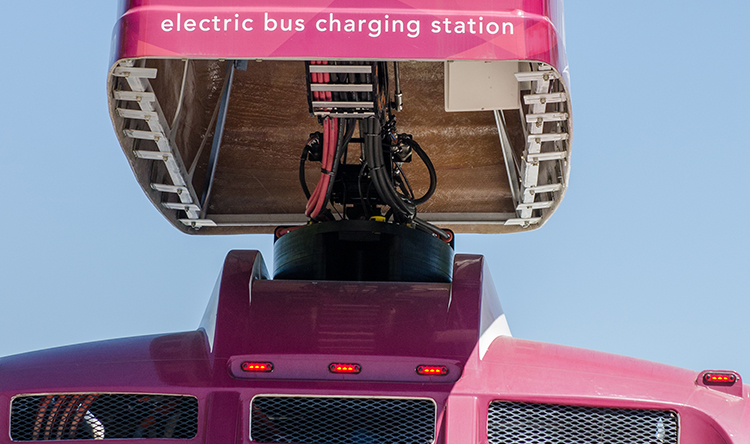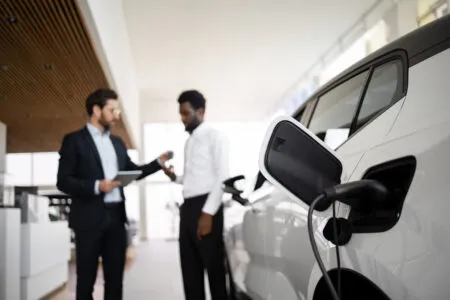Converting a fleet to all-electric involves a lot more than buying new vehicles and accepting the charge they provide. There are many infrastructure needs and operational strategies to consider, including where to place chargers, what kinds of chargers you need and who owns the charging system. Justin Merkel, senior distribution manager at HDR, discusses how fleet operators can save money by investing in the correct setup.
A key consideration is developing a charging strategy to manage electric demand, and you do that by designing infrastructure and operating protocols that provide for cost-effective charging and electric fleet operation.
What are key design and operational strategies when adding new charging infrastructure to support an electric fleet?
Managing electric demand is a critical consideration when designing charging infrastructure to support cost effective and reliable fleet operations. Electric demand charges are fees, beyond energy usage, levied on commercial and industrial customers based upon the highest amount of power drawn during a typical 15-minute interval in a billing period. This fee impacts customers who have large electricity loads over a short time. Focused energy use studies can help identify operating strategies and design needs to level out energy usage and reduce electric demand, which keeps infrastructure costs lower for both the utility and the electric fleet owner.
How to achieve an optimized level of electric charging depends on factors such as the number of vehicles in the fleet, vehicle design, how fast recharging is needed, the number of chargers and frequency of charging. For example, the lowest-cost charging system would use the smallest charger, evenly operated throughout a 24-hour period, including during vehicle operation. However, in almost all cases without a direct circuit connection, it’s not practical at this time to charge vehicles while in use, so designers look for ways to create something similar to continuous-charging. For instance, fleet owners and system designers should look for any opportunity to recharge batteries when a vehicle is not operating.
Other strategies include having spare vehicles so that a portion of the fleet is always charging, charging the fleet during off-peak hours, purchasing and charging an on-site battery for electricity storage or sharing a meter and the costs with another heavy user that has a complementary electric demand. Fleet owners may also choose higher capacity chargers to reduce charging time on a per vehicle basis, which would use the same electric demand as multiple lower capacity chargers paired with individual vehicles for a longer period of time.
Many other variables also play into designing an electric fleet charging system, including geography, climate variables, operating temperature and manufacturer equipment. We’ve developed the Zero+ Fleet Optimization tool that can model options for a fleet and its specific routes, taking into account all those factors. The options developed by the modeling tool allow the fleet owner to see the total electricity usage and the impact of different operating scenarios. The fleet owner/operator can then choose to invest in what makes the most sense to meet their priorities, considering options such as en-route charging to extend the daily range or managed-period charging instead of unmanaged charging.
Making the right decisions upfront can avoid potentially large electric demand charges that will be much harder to mitigate later. Involving fleet operations staff during the early design stages should help avoid creating new issues impacting current operation as a result of electric fleet adoption. And finding the most efficient use of available resources can save a lot of money over the fleet lifecycle.

What are the different types of electric vehicle chargers available for fleets and how do they work?
Battery charging technology is in constant flux, and there’s no one set standard. There are three basic styles of battery chargers: plug-in, pantograph and induction.
Plug-in chargers are the prevalent charging technology and are the simplest to install. They resemble a traditional fuel pumping station except the fuel nozzle is an electric cord with a plug. Using a plug-in charger is simple, however standard plug configurations are still being developed with several unique configurations available today. Charging spaces are needed for each vehicle, whereas typical petroleum-based fueling is centralized to a pump platform; the need for charging spaces often will result in a larger parking footprint to provide the space.
A pantograph-style charger is a system, often overhead, that makes direct electrical contact with the vehicle similar to what you would see with an electric train. The charging system is engaged and the charge-cycle is completed while the vehicle is stationary.
An induction system is wireless transfer of electric energy by electro-magnetic fields just like the wireless charger for your mobile phone. The pantograph and induction charger require precise positioning of the vehicle. Some systems make vehicle positioning easier by doing it autonomously.
Currently there’s no charger that can transfer energy as fast as refueling a vehicle at a traditional gas/diesel fuel station, though new technologies are in the works to close that gap. Batteries continue to improve and direct-current fast-chargers (DCFC) are increasing in capacity. There is an industry group currently working on a new guidance standard for High Power Charging for Commercial Vehicles — that would allow for a charging current in excess of 1 megawatt, which would improve large vehicle charging time.
A benefit of electric fleets is that vehicles can charge wherever there is a power source. For example, if a vehicle has a 10-minute delay at a loading dock or transit station, these places can become charging stations with the right infrastructure setup. A key consideration again is managing the electric demand to maintain cost-effectiveness.
What are the typical ownership structures for charging stations, and what are the benefits and drawbacks?
The traditional ownership model is one in which the electric utility owns and operates the transmission system up to the metering point, and the fleet customer owns the system downstream of the meter. There are deviations from this as each state has its own public utility commission that regulates the electric utility. As electric utility systems have evolved, public utilities have established rules to define ownership, maintenance and installation costs. The jurisdiction where the fleet owner resides will dictate what portion the fleet owner is obligated to maintain.
Another model is where the fleet owner also owns the charging system. This gives the owners more flexibility. They can choose to use solar panels, battery storage or net metering, and at the same time be innovative in finding alternatives to the traditional electric usage. A potential downside is that not all fleet owners have access to a qualified electrician who can work on medium voltage systems. Utilities already have the equipment and staff to work on medium and high voltage electrical systems.
For most commercial customers, electric utilities typically own electric equipment higher than 1,000 volts. That’s likely to change as more and more fleet owners move to electric and their installations transition from something that looks like a commercial installation to a system that resembles an industrial installation requiring medium voltage systems (1 kV to 34.5 kV).
In states that are promoting electrification, public utility commissions are allowing utilities to incentivize electrical vehicles. Programs such as “make-ready” where utilities are still responsible for maintenance and operations make it easier for the fleet owner to transition to electric vehicles.
Traditional fleet owners are generally not familiar with connecting to the electric grid at medium and higher voltages. The electric system is a complicated system and having an energy professional that understands electric rates, tariffs and electric utility operations can assist a fleet owner in making prudent decisions for capital investments and long term operation and maintenance costs.
Beyond the charging infrastructure, what other factors should fleet owners consider when going electric?
Fleet operators will need to change their mindset on operating practices to accommodate the unique needs and extended fueling time of an electric fleet. These changes include everything from number of vehicles to staff training. For example, a higher number of spare vehicles may be needed to support the same functions because charging takes longer than refueling. As electric vehicle technology improves, a smaller fleet may be possible as better reliability with electric motors compared to combustion engines could reduce the need for spares on site.
Geography (grade changes), head-wind, and extreme hot and cold climates can impact the amount of battery energy consumed and therefore the distance traveled between charges, resulting in potential route modifications. Mechanics will need to be trained on electric components and safety.
Utilities are offering incentives for early adopters of EVs in order to learn more about the market. Some utilities have time-of-use metering where reduced rates are offered as an incentive for energy consumption during off peak times, which can significantly reduce fleet energy costs. Knowing what a fleet owner’s local electric utility is doing to incentivize or support electric vehicle adoption can help offset initial start-up costs.
An EV fleet will significantly change power needs. What conversations should fleets have with utilities and the community?
Utility companies are new to the electric vehicle market as well and are still determining what impact this new load will have on the electric grid. Understanding the rate structure of the electric utility is important for understanding what kind of infrastructure to install. Fleet owners should be sharing their implementation studies and plans with the electric utility early and often to better understand short term and long term costs for both capital investment and operation. The utility will want a realistic forecast of electric load to begin the planning process for the needed infrastructure to support new loads. Fleet owners should anticipate that their relationship with the power utility owner will likely change from a lower-level commercial basis to that of an industrial user.
EV fleet loads are new to the electric utility industry, so comprehensive actual load data is not readily available. Utilities tend to be conservative in their electric load assumptions. Accurate modeling like our Zero+ Fleet Optimization tool can assist with providing realistic forecasts of the electric energy profile to share with the utility. Having robust, accurate data can help keep initial infrastructure costs down by understanding the specific requirements for charging. Phasing in the electric fleet allows the utility time to respond and react to the fleet electric load.
Conversations with communities can provide opportunities for charge or load sharing. For example, when the fleet is out of the yard, there could be opportunities for other vehicles to occupy the fleet space. Or an electric fleet could share a meter with a processing plant that has large daytime electric use similar to the demand for overnight fleet charging. This would reduce the demand charge for the electric consumers and the electric utility would have a consistent electric load.





